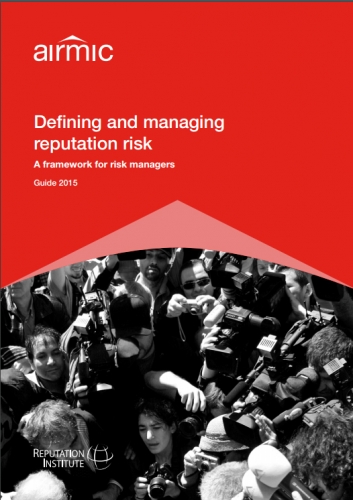Defining and managing reputation risk
Introduction
The objective of the guide is to enable risk managers to lead an organisation’s approach to reputational risk management. The guidance sets out a framework for breaking down the elements of an organisation that govern its reputation. Risk managers can use this framework to identify the possible risk events that affect each of these dimensions, and the stakeholders that are subsequently affected. This will allow for a structured approach to managing reputational risk.
Reputation risk is an ongoing yet growing concern for companies. Airmic members report reputational risk as both their number one ‘keep’s me awake at night issue’ and a high concern for their executive management and Board. This is no surprise in today’s world where social media has made it possible for news to travel around the world within minutes and the perception of who you are as a company has a direct impact on several factors, including sales, stock price and licence to operate. High-profile incidents such as BP’s Deepwater Horizon oil spill disaster in 2010 alert companies that a reputational problem can cause short-term issues to develop into long-term impacts including reduced profits, loss of customers and key employees, and eventually a slump in share price.
Despite this concern, only a third of Airmic members have a high degree of confidence in how their firms manage reputational risk and just 3% of members currently purchase insurance cover for reputational exposures. Airmic members specifically report that they face hurdles in determining how to define and value reputational risk. However, with pressure from above three-quarters of members plan to develop an approach to reputational risk management in the next 12 to 18 months. Kasper Nielsen, Executive Partner at Reputation Institute, can understand the difficulty: “Reputation is the perception others have of you. It’s a feeling, which makes it intangible. And managing something which is hard to define is difficult. To understand reputation you need to make the intangible tangible. You need to break down your reputation into specific components that you can measure and manage. Then you are able to identify the specific impact from a crisis or an issue on your reputation and manage it.”
The goal is clear–to outline a systematic process for identifying, evaluating and mitigating reputation risk. Airmic engaged with Reputation Institute, whose RepTrak® framework identifies the seven ‘reputation dimensions’, which govern how stakeholders perceive an organisation.
This guide describes this framework and maps out a simple and structured approach for using it to manage reputational risk. In addition, the guide considers that although the current market for dedicated reputational products is limited, the individual events that can dent an organisation’s reputation often are insurable. This can place risk and insurance managers in a better position for leading the organisation’s response to reputational risk. Appendices at the end of guide provide example matrices which can be used to identify the possible events and the key stakeholders that determine an organisation’s reputation.
- Fill out an application Our membership manager will assess your eligibility against our criteria.
- Complete your profileIf you are eligible for membership you will be asked to answer a few questions about yourself.
- PaymentYou can make payment online using a card or request an invoice.

